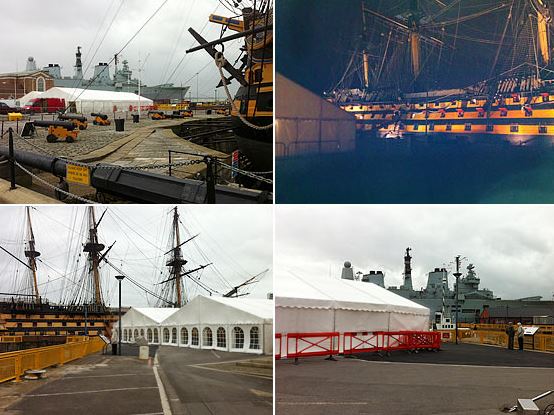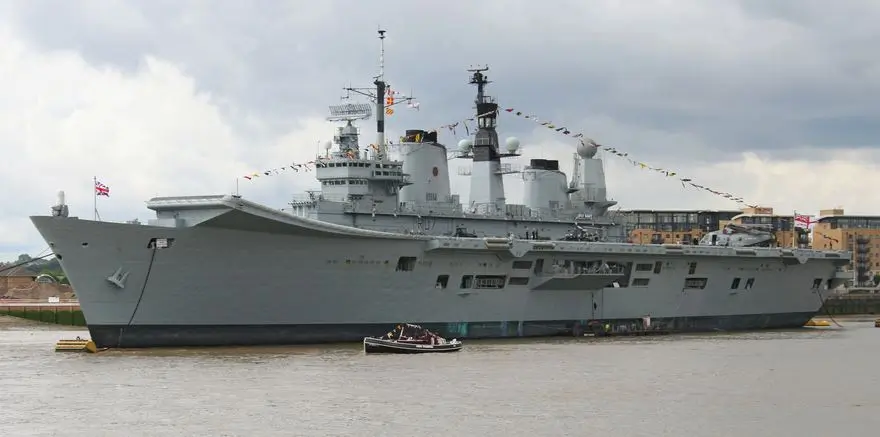The Ark Royal holds a distinguished place in the history of the British Royal Navy as the last ship to bear this prestigious name. Spanning over several centuries, the name Ark Royal has been associated with a series of aircraft carriers that played vital roles in shaping naval warfare and aviation. The Ark Royal we are discussing here was the most recent and final vessel to carry the name, an Invincible-class aircraft carrier commissioned in 1985. After an illustrious 25 years of service, the ship was decommissioned in 2011, marking the end of her era in the Royal Navy.
This blog aims to answer the question: Where is the Ark Royal now? By delving into the ship’s storied history, its vital contributions during major conflicts such as the Falklands War and Gulf War, and its ultimate fate following decommissioning, we will uncover the legacy of this iconic vessel and its final journey.
History and Significance of the Ark Royal
The Ark Royal was commissioned into the British Royal Navy in 1985 as an Invincible-class aircraft carrier. This class of carriers was designed to provide the Royal Navy with a versatile platform for operating fixed-wing aircraft and helicopters, especially during times of conflict. The Ark Royal was at the forefront of modern naval aviation and played a crucial role in several high-profile operations throughout her service.
One of the ship’s most notable contributions came during the Falklands War in 1982. Although the Ark Royal had not yet been commissioned, her predecessor, the fourth Ark Royal, had served as the flagship of the British task force during this conflict, marking the Ark Royal name with significant historical importance.
Throughout her career, the Ark Royal was actively involved in operations during the Gulf War, as well as peacekeeping missions in the Balkans and the Middle East. She became a symbol of British naval power, capable of launching Harrier GR5 aircraft for air strikes and providing support for other operations through her ability to carry and deploy helicopters. The ship’s role in naval aviation was pivotal, with her ski-jump design enabling aircraft to take off without the need for a catapult, giving her more flexibility in operation.
As an Invincible-class carrier, the Ark Royal had a distinctive design with a ski-jump ramp to launch aircraft, a well-deck for helicopter operations, and an air group that could operate Harrier jets. This made the Ark Royal a formidable asset to the Royal Navy, offering a multi-purpose platform for both air and sea operations.
Despite its powerful presence, after 25 years of service, the Ark Royal was decommissioned in 2011 as the UK began transitioning to newer ships in the Queen Elizabeth class. The decommissioning marked the end of a significant chapter in the history of British naval aviation.
Retirement and Decommissioning
In 2011, after 25 years of service, the Ark Royal was officially decommissioned from the British Royal Navy. The decision to retire the ship was part of a broader shift in the Royal Navy’s fleet strategy. By that time, the ship had undergone numerous upgrades and had been a vital asset to British naval operations, particularly in the Gulf War and the Falklands War. However, the Ark Royal was approaching the end of its operational life, and the UK was moving forward with newer, more advanced aircraft carriers as part of a long-term modernization plan.
The British Navy’s decision to retire the Ark Royal was influenced by several factors. One significant reason was the financial constraints facing the UK government, which made it necessary to prioritize newer and more capable ships. In 2010, the UK government unveiled plans for two new aircraft carriers, the HMS Queen Elizabeth and HMS Prince of Wales, which would eventually replace the Ark Royal. These new ships were designed to carry the newer generation of aircraft and provide more operational flexibility, making the Ark Royal somewhat obsolete in comparison.
Initially, there were plans to sell the Ark Royal for scrap. However, public outcry and debates about the ship’s legacy led to a brief consideration of other options, including preserving her as a museum ship. Ultimately, though, the Royal Navy decided that selling the ship was the most practical option.

What Happened After Decommissioning?
Following her decommissioning, the Ark Royal embarked on a post-retirement journey that captured the public’s attention. The British government put the ship up for sale, with the intention of selling her to a private buyer. Several interested parties emerged, including ship-breaking companies, which led to speculation about her fate. There was a great deal of uncertainty surrounding the future of the Ark Royal, particularly in terms of whether it would be preserved as a museum or sent for dismantling.
In the end, the Ark Royal was sold to a private buyer, and her final destination was a scrapyard in Turkey, where she was dismantled and scrapped. The public’s interest in her fate highlighted the deep affection that many people had for the ship and her historical significance. Unfortunately, despite the discussions about potentially preserving her, the Ark Royal did not escape the fate of being dismantled, marking a somber end to her storied service history.
The decision to scrap the Ark Royal was met with some disappointment, especially among those who hoped the ship could serve as a reminder of the Royal Navy’s aviation legacy. However, it ultimately represented a natural conclusion to the vessel’s lifecycle, following her retirement and the arrival of newer ships to continue Britain’s naval prowess.
Dismantling and Final Days
After the Ark Royal was sold to a private buyer, the final chapter of its storied career began. In 2013, the ship was towed to a scrapyard in Turkey, where it was dismantled. The decision to send her to a ship-breaking yard marked the end of the Ark Royal’s journey, after a final stint of more than two decades serving the Royal Navy.
The dismantling process began in the Turkish port of Aliaga, one of the most prominent ship-breaking locations in the world. Here, large vessels like the Ark Royal are carefully deconstructed, with materials such as steel and metal being recycled and reused. The decommissioning of such a significant ship is a meticulous and often poignant process, especially for those who served aboard or admired the Ark Royal throughout her active life.
The Ark Royal’s dismantling was a somber occasion for many, as it marked the conclusion of a remarkable chapter in British naval history. For those who had witnessed the ship’s operations during the Falklands War, Gulf War, and peacekeeping missions, the sight of her being torn apart symbolized the end of an era in naval aviation and military prowess. Despite the sadness surrounding her disposal, the Ark Royal’s legacy endures, both in the hearts of those who served aboard her and in the broader history of the Royal Navy.
Legacy of the Ark Royal
The Ark Royal leaves behind a significant legacy in the annals of British naval history. As an Invincible-class aircraft carrier, it was at the forefront of naval aviation, playing a critical role in multiple military conflicts. The ship’s contributions during the Falklands War and Gulf War were particularly important, as she provided air support and helped project British power across the globe. Her ability to operate Harrier jets and a wide array of helicopters demonstrated the versatility and reach of the Royal Navy during a period of technological advancements in warfare.
Furthermore, the Ark Royal was instrumental in shaping modern naval aviation, helping the Royal Navy maintain a credible and effective presence on the global stage. Her design, featuring a ski-jump ramp to launch aircraft, was a significant advancement in the use of carriers for vertical take-off and landing (VTOL) aircraft, ensuring the ship remained a key asset in the fleet for many years.
Despite her prominent history, there were no serious efforts to preserve the Ark Royal as a museum ship after her decommissioning. While there was public interest in preserving the ship for posterity, the cost and logistics of maintaining such a large vessel, coupled with the absence of a dedicated museum space, led to her eventual disposal. This decision was met with disappointment by many who hoped to see the Ark Royal live on as a symbol of naval heritage, reflecting on her legacy and the vital role she played in military history.
Conclusion
The Ark Royal‘s retirement and dismantling in 2013 marked the end of a remarkable era for the British Royal Navy. After 25 years of distinguished service, including participation in key military conflicts, she was sold and ultimately scrapped in Turkey. While her final days were filled with uncertainty and public interest, the ship’s legacy is undeniable.
The Ark Royal will be remembered for its contributions to naval aviation, its role in important global operations, and its iconic status in British naval history. Though no longer in service, ships like the Ark Royal continue to be admired for their historical significance, even after their decommissioning. Their stories live on in the memories of those who served aboard them and the lasting impact they left on naval strategy and technology. The Ark Royal may no longer sail the seas, but her legacy will forever be anchored in the history of the Royal Navy.
FAQ: Where is the Ark Royal Now?
1. What was the Ark Royal?
The Ark Royal was the last ship to bear the prestigious name in the British Royal Navy. It was an Invincible-class aircraft carrier commissioned in 1985 and served for 25 years until it was decommissioned in 2011. Known for its role in various military conflicts, including the Falklands War and the Gulf War, it was a key part of Britain’s naval aviation capabilities.
2. Why was the Ark Royal decommissioned?
The Ark Royal was decommissioned after 25 years of service in 2011, primarily due to age and the Royal Navy’s shift towards newer aircraft carriers like the HMS Queen Elizabeth. Financial constraints and technological advancements in naval warfare made the Ark Royal less essential in comparison to the next-generation ships.
3. What happened to the Ark Royal after it was decommissioned?
After its decommissioning, the Ark Royal was put up for sale. Initially, there were plans to scrap the ship, but it was sold to a private buyer in 2013. The ship was then sent to a scrapyard in Turkey, where it was dismantled and recycled.
4. Why wasn’t the Ark Royal preserved as a museum ship?
Despite public interest in preserving the Ark Royal as a museum ship, the costs and logistical challenges of maintaining such a large vessel, combined with the absence of a dedicated space to house her, meant that preserving the ship was not feasible. As a result, the ship was ultimately dismantled.
5. Where was the Ark Royal dismantled?
The Ark Royal was sold to a ship-breaking company and taken to a scrapyard in Aliaga, Turkey. This is one of the world’s largest ship-breaking locations, where large vessels like the Ark Royal are carefully deconstructed for recycling.
6. What role did the Ark Royal play in military conflicts?
The Ark Royal played an important role in several key military conflicts, including the Falklands War in 1982 and the Gulf War in 1991. It provided crucial air support during these operations, with its ability to carry Harrier jets and helicopters proving vital for British naval operations.
7. When was the Ark Royal last operational?
The Ark Royal was last operational in 2011 before its decommissioning. After 25 years of service, it was retired as the Royal Navy looked to newer aircraft carriers to replace it.
8. Was there any public interest in preserving the Ark Royal?
Yes, there was significant public interest in preserving the Ark Royal as a museum ship due to its historical significance. However, no concerted effort was made to save the ship, leading to its eventual dismantling.




